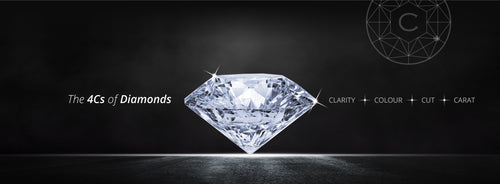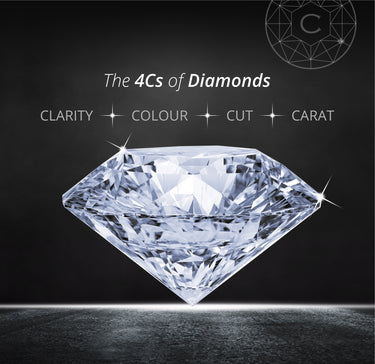Subscribe to newsletter
Add descriptive text to invite your users to sign up for your newsletter.
There are four factors that determine the value of a diamond, collectively known as the 4Cs of Diamonds. The best way to shop for a diamond is to have a good understanding of the 4Cs and determine which factors are most important to you, as each “C” means something different for each individual.
For example, some individuals care most about the carat weight, while others might consider the clarity and cut more important. A diamond jewellery purchase should never be based on the specifications alone.
Carat weight is one of the 4Cs of diamonds that measures a diamond’s weight and size. The term "carat" is derived from the carob seeds that were used to balance scales in ancient times.
Today’s metric carat is equal to 200 milligrams, or one-fifth of a gram, and there are approximately 142 carats to an ounce. Carats are further divided into points. There are 100 points in a carat. A half-carat diamond may be referred to as a 50-point stone.

Because large diamonds are rare, they generally have a greater value per carat. When considering the value of a diamond or gemstone, two diamonds or gems of equal carat weight can have different price points based on the quality of cut, colour & clarity, the three other diamond quality factors.

| CKJ - Diamond Weight Chart | |||
| Carat Total Weight Range | Fractional Carat Total Weight | Minimum Carat Total Weight | Minimum Carat if Solitaire/Certified Center |
| .005-.084 | Diamond Accent | Diamond Accent | |
| .085-.109 | 1/10 | 0.085 | |
| .110-.139 | 1/8 | 0.11 | |
| .140-.179 | 1/6 | 0.14 | |
| .180-.229 | 1/5 | 0.18 | |
| .230-.289 | 1/4 | 0.23 | |
| .290-.369 | 1/3 | 0.29 | 0.30 |
| .370-.449 | 3/8 | 0.37 | 0.40 |
| .450-.579 | 1/2 | 0.45 | 0.50 |
| .580-.699 | 5/8 | 0.58 | 0.60 |
| .700-.819 | 3/4 | 0.70 | 0.70 |
| .820-.949 | 7/8 | 0.82 | 0.90 |
| .950-1.14 | 1 | 0.95 | 1.00 |
| 1.15-1.39 | 1 1/4 | 1.15 | 1.20 |
| 1.40-1.64 | 1 1/2 | 1.40 | 1.50 |
| 1.65-1.89 | 1 3/4 | 1.65 | 1.70 |
| 1.90-2.14 | 2 | 1.90 | 2.00 |
| 2.15-2.39 | 2 1/4 | 2.15 | 2.20 |
| 2.40-2.64 | 2 1/2 | 2.40 | 2.50 |
| 2.65-2.89 | 2 3/4 | 2.65 | 2.70 |
| 2.90-3.39 | 3 | 2.90 | 3.00 |
| 3.40-3.89 | 3 1/2 | 3.40 | 3.50 |
| 3.90-4.39 | 4 | 3.90 | 4.00 |
| 4.40-4.89 | 4 1/2 | 4.40 | 4.50 |
| 4.90-5.39 | 5 | 4.90 | 5.00 |
Diamonds come in every color of the spectrum, but the most popular are colorless. Truly colorless, pure white diamonds are extremely rare and, therefore, costlier. Laboratories, like the Gemological Institute of America (GIA), grade stones according to how far they deviate from the purest white as one of the diamond 4Cs.
The best way to see the true color of a diamond is by looking at it against a white surface. Colorless stones are graded D, E or F. All three grades are considered colorless but with slightly decreasing transparency. Color grading continues down through the alphabet, with each letter designating a slight darker or warmer tint.

Diamonds also come in a spectrum of majestic colors, from red and canary yellow to blue, green and purple. These colorful diamonds, known as fancies, are valued for their depth of color, just as white diamonds are valued for their lack of color. Therefore, fancy color diamonds are graded in order of increasing intensity from Faint, Very Light, Light, Fancy Light, Fancy, Fancy Intense, Fancy Vivid, Fancy Dark and Fancy Deep. Intense fancies are rare, therefore, very costly.
Diamond color grades are determined by professionals under ideal circumstances, a situation seldom duplicated outside of a laboratory. Choose a diamond based on its appeal to you, rather than on a technical color scale.
A diamond’s clarity, one of diamonds 4Cs, is affected by any external and internal characteristics created by nature when the diamond was formed or as a result of the cutting process.
Characteristics such as internal spots or lines are called inclusions. Although these marks make each stone unique, the fewer the inclusions, the more valuable the stone. Inclusions can sometimes interfere with the passage of light through the stone, diminishing the sparkle and value of the diamond.

According to the quality analysis system of the Gemological Institute of America (GIA), clarity is graded on a scale ranging from Flawless (Fl) to Imperfect (I).Only a tiny percentage of diamonds ever achieve the grade of Flawless.
To many, cut is considered the most important of aspect of a gemstone’s quality and value. Diamond cut affects some of its optical and physical properties including how it reflects light and sparkles.
The Diamond Cut Process
Diamond cut refers to how the jeweller physically cuts the diamond stone into its shape, proportions and symmetry that achieve optimal light dispersion & affects a diamond’s quality and price.
Each diamond is cut to exact standards. Let’s look at the process to cut a beautiful diamond to understand the terminology the jewellery industry uses to explain diamond-cut factors.
The most common cut, the round brilliant, has 58 facets designed to yield the maximum amount of light.

A diamond’s reflectiveness, also known as brilliance, is an extremely important factor in evaluating the quality of a diamond’s cut. A poorly cut diamond will lose light and appear dull.
The widest circumference of a diamond is known as the girdle. Above the girdle of a brilliant-cut diamond are 32 facets plus the table, which is the largest and topmost facet. Below the girdle are 24 facets plus the culet, or point.

Proportion diagrams will typically include the following information:
Depth: The height of a gemstone measured from the culet to the table.
Table: Located at the top of the diamond, the table is the largest facet of a diamond.
Girdle: Range of girdle thickness.
Culet: Appearance, or lack thereof, of the culet facet.
A diamond’s cut impacts four aspects of the stone’s optical and physical properties:
Lustre: The quality and amount of light that is reflected off just the surface of the diamond. Lustre is directly related to the hardness of the stone and the quality of its polish.
Brilliance: The amount of white light that is returned to the eye from both internal and external surfaces. Brilliance is determined by the quality of the diamond’s polish and the number and size of inclusions inside the gem.
Dispersion: The display of spectral or rainbow colors seen coming from the inside of a diamond. Often referred to as fire, dispersion is directly related to how well the stone is proportioned.
Scintillation: A diamond will show scintillation, or sparkle, when movement is involved. The viewer, the light source or the diamond itself must be in motion for scintillation to occur.
Diamonds are cut into many different shapes, each with their own aesthetic and cutting requirements. While diamonds are sometimes referred to as the cut (for example an emerald-cut diamond), the cut refers to how a jeweller cuts the stone to achieve its symmetry and proportion.

Most people are familiar with the round solitaire diamond and common "fancy" shapes -- which refer to stone cut in any shape other than round. Fancy cuts include such shapes as baguette, emerald, triangle, pear, princess, oval and marquise. If you are uncertain about a term used to describe your diamond, ask our diamond experts to clarify it for you.

Grading Reports are meant to provide clarity, and yet consumers often get so focused on the data they forget about the most important aspect of the diamond or gem: it’s beauty and the feelings it inspires. Here are answers to the most common consumer questions when it comes to diamond and gem grading reports.
While a diamond grading report can help explain the quality factors like color, clarity, cut and carat weight, it should not be a primary factor when shopping for a diamond. Our diamond expert can help you understand their unique characteristics and determine the best diamond for your budget.
Let’s start with what a diamond grading report is not: It is not a jewellery appraisal or a certificate of the stone’s value. Key differences:
Consider a grading report a blueprint of a diamond’s properties that verifies diamond authenticity and quality. As you search for your perfect diamond, a grading report can help explain the quality factors of the stone based on scientific properties, but it is still subjective in that it is the opinion of the individuals who graded the diamond and is based on the lab’s grading standards. This is why there are sometimes minor discrepancies between grading reports from different labs.
A diamond grading report describes in detail the characteristics of an unmounted diamond. How that information is referenced the varies depending on the lab, but most grading reports contain:
Diamond and gemstone grading reports are provided by laboratories within the jewellery industry. Here are some of respected labs that offer diamond and gemstone grading reports or certificates:
Gemological Institute of America (GIA)
International Gemological Institute
Gem Certification & Assurance Lab (GCAL)
American Gem Society (AGS)
GS Laboratories Inc.
Understanding the various jewellery metal options for your fine jewellery will help you build a jewellery wardrobe that fits your life and style.
Fine jewellery metals have captured imaginations for centuries. You may prefer one kind of metal, or you may be surprised to discover a new favourite among the wide range of metals used in jewellery today.
Each has its distinct advantages, unique looks and applications for jewellery. Understanding the qualities of each type of jewellery metal can help ensure that the piece you select today will offer a lifetime of joy and satisfaction.
How to Care for Jewellery
Each jewellery metal or material requires special care. Here are some general care tips for metal jewellery to keep your jewellery timeless:
Jewellery Cleaning

Use these simple, basic guidelines for the care and cleaning of your fine jewellery:
Prevent Jewellery Loss & Repairs
Fine jewellery is a precious possession designed and crafted to last generations, but proper care is required to ensure the lasting qualities of your jewellery. At Carat Kings, you can always drop in to have your jewellery checked for loose prongs, worn mountings, and general wear and tear. Visit us if you feel there is a need to have your jewellery professionally cleaned.
Configure your language and/or currency

